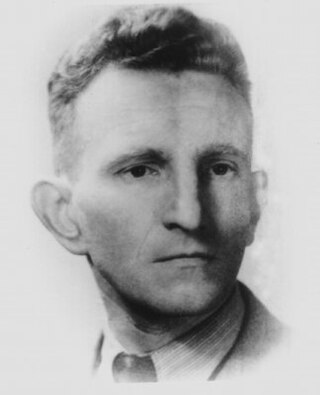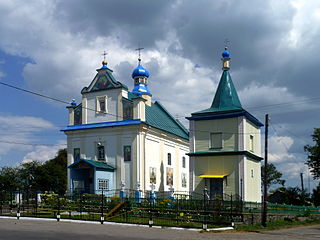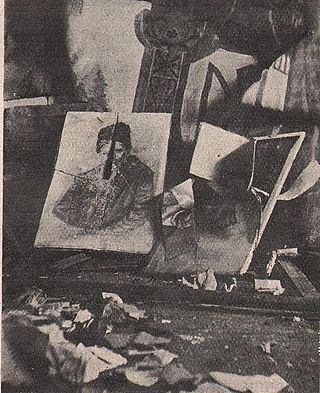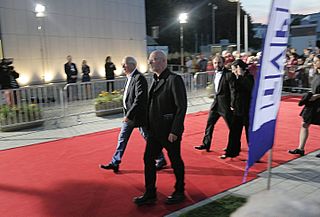
The massacres of Poles in Volhynia and Eastern Galicia were carried out in German-occupied Poland by the Ukrainian Insurgent Army (UPA) with the support of parts of the local Ukrainian population against the Polish minority in Volhynia, Eastern Galicia, parts of Polesia and Lublin region from 1943 to 1945. The ruling Germans also actively encouraged both Ukrainians and Poles to kill each other. The peak of the massacres took place in July and August 1943. The massacres were exceptionally brutal and affected primarily women and children. The UPA's actions resulted in up to 100,000 deaths. Other victims of the massacres included several hundred Armenians, Jews, Russians, Czechs, Georgians, and Ukrainians who were part of Polish families or opposed the UPA and sabotaged the massacres by hiding Polish escapees.

The Ukrainian Insurgent Army was a Ukrainian nationalist paramilitary and partisan formation founded by the Organisation of Ukrainian Nationalists on October 14, 1942. During World War II, it was engaged in guerrilla warfare against the Soviet Union, Nazi Germany and both the Polish Underground State and Communist Poland.

Roman-Taras Yosypovych Shukhevych was a Ukrainian nationalist and a military leader of the nationalist Ukrainian Insurgent Army (UPA), which during the Second World War fought against the Soviet Union and to a lesser extent against the Nazi Germany for Ukrainian independence. He collaborated with the Nazis from February 1941 to December 1942 as commanding officer of the Nachtigall Battalion in early 1941, and as a Hauptmann of the German Schutzmannschaft 201 auxiliary police battalion in late 1941 and 1942.

Pavlivka is a town now located in northwestern Ukraine, in Volodymyr Raion of Volyn Oblast, near Volodymyr, on the Luha river. For centuries, Poryck was property of several noble Polish families. The town is the birthplace of a Polish statesman Tadeusz Czacki. On 11 July 1943, the Ukrainian Insurgent Army, supported by local nationalists murdered here more than 300 Polish civilians, who had gathered in a local Roman Catholic church for a Sunday ceremony.

Mykola Kyrylovych Lebed or Lebid, also known as Maksym Ruban, Marko or Yevhen Skyrba, was a Ukrainian nationalist political activist and guerrilla fighter. He was among those tried, convicted, and imprisoned for the murder of Polish interior minister Bronisław Pieracki in 1934. The court sentenced him to death, but the state commuted the sentence to life imprisonment. He escaped when the Germans invaded Poland in 1939. As a leader of OUN-B, he was responsible for the massacres of Poles in Volhynia and Eastern Galicia.
Sluzhba Bezpeky or SB OUN, was the Ukrainian partisan underground intelligence service, and a division of the Organization of Ukrainian Nationalists responsible for clandestine operations and anti-espionage during World War II. In its short history, the SB committed acts of terror against civilians and non-civilians and their families, including people suspected either of collaborating, or serving with the Soviet forces in western Ukraine. In this capacity, the SB also played a significant role in the ethnic cleansing and killing of the Polish population in Volhynia and Galicia.

Dmytro Semenovych Klyachkivsky, also known by the pseudonyms of Klym Savur, Okhrim, and Bilash, was a commander of the Ukrainian Insurgent Army (UPA), first head-commander of the UPA-North. He was responsible for the ethnic cleansing of Poles from Volhynia.
Kurdybań Warkowicki, or Kurdyban–Warkowicki, was a Polish village in Wołyń Voivodeship (1921–1939) before the joint Nazi German and Soviet invasions of Poland in 1939. It was located near the town of Warkowicze in Dubno County, in the eastern part of the Second Polish Republic. The village was eradicated during the Polish population transfers after World War II, when the Kresy macroregion was formally incorporated into the Soviet Union.

Bortnytsia is a village in Rivne oblast, near the town of Dubno, in Dubno Raion, Ukraine. The village currently has a population of 365.
Kysorychi is a village located in Sarny Raion, Rivne Oblast, Ukraine, but was formerly administered within Rokytne Raion. Before the 1939 Nazi German and Soviet invasions of Poland, the village was named Kisorycze and was located in Gmina Kisorycze, Sarny County, Wołyń Voivodeship in the eastern part of the Second Polish Republic. The biggest employer in the area was a glass factory in Rokytne (Рокитне) 8 km north of town, employing 400 workers.
Pańska Dolina no longer exists. The village was liquidated during the Polish population transfers after World War II, when the Kresy macroregion was formally incorporated into the Soviet Union. Pańska Dolina used to be located in Gmina Młynów, Powiat Dubno (county), of the Wołyń Voivodeship, before the Nazi German and Soviet invasions of Poland in September 1939. Its former location can be found near Mlyniv in Dubno Raion of present-day Ukraine.
Stanisław Jastrzębski is a Polish writer, lawyer and historian.

Ewa Siemaszko is a Polish writer, publicist and lecturer; collector of oral accounts and historical data regarding the Massacres of Poles in Volhynia. An engineer by profession with Master's in technological studies from the Warsaw University of Life Sciences, Siemaszko worked in public health education and also as a school teacher following graduation. She is a daughter of writer Władysław Siemaszko with whom she collaborates and shares strong interest in Polish World War II history.

Józef Turowski was a Polish military historian.

The Pacification of Ukrainians in Eastern Galicia was a punitive action against the Ukrainian minority in Poland, carried out by police and military of the Second Polish Republic from September until November 1930 in reaction to a wave of sabotage and terrorist attacks perpetrated by Ukrainian nationalists.

Było sobie miasteczko... is a 2009 Polish historical documentary film about the 1943 Kisielin massacre in the village of Kisielin, located in the Wołyń Voivodeship in Poland before World War II,. The film, directed by Tadeusz Arciuch and Maciej Wojciechowski, was produced by Adam Kruk for Telewizja Polska.

The assassination of Bronisław Pieracki was a target killing of a Polish politician of the interwar period, Minister of Interior Bronisław Pieracki (1895-1934), by the Organization of Ukrainian Nationalists (OUN).

Volhynia or Hatred is a 2016 Polish war drama directed by Wojciech Smarzowski. The film is set in the 1939–1943 time frame and its central theme is Ukrainian anti-Polish hatred culminating in massacres of Poles in Volhynia. The screenplay was based on the collection of short stories titled Hate by Stanisław Srokowski.

On Sunday, 11 July 1943, OUN-UPA death squads, aided by local Ukrainian peasants, simultaneously attacked at least 99 Polish settlements within Wołyń Province of the German-occupied prewar Second Polish Republic. It was a well-orchestrated attack on people gathered at Catholic churches for Sunday mass. The towns affected included Kisielin, Poryck, Chrynów, Zabłoćce, and Krymn, while dozens of other towns were attacked on other dates; tens of churches and chapels were burned to the ground.

Budy Ossowskie massacre was a mass murder of ethnic Poles carried out on 29–30 August 1943 by a death squad of the Ukrainian Insurgent Army aided by the Ukrainian peasants during the Massacres of Poles in Volhynia and Eastern Galicia. About 290 people were killed, including women and children, all of them, Polish inhabitants of the Budy Ossowskie village, located in the Kowel County of the Wołyń Voivodeship in the Second Polish Republic. Budy Ossowskie village does not exist anymore. It was burned to the ground by the OUN-UPA. The charred remnants of the village were cleared in Soviet Ukraine for grazing cattle. Overall, in the Kowel County some 7,300 ethnic Poles were murdered.
















